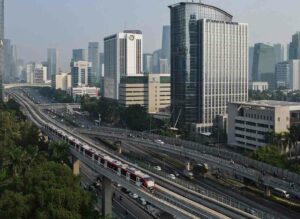




Monthly Economic Update: One for the road
 DOWNLOAD
DOWNLOAD

Inflation Update: Still low, still slow
 DOWNLOAD
DOWNLOAD

Philippines Trade Update: Exports momentum continues
 DOWNLOAD
DOWNLOAD


Asian economies ‘on track’ to fuel global growth — IMF

ECONOMIES in the Asia region are expected to continue contributing significantly to global growth, as Asian central banks loosen monetary policy later this year amid easing inflation, the International Monetary Fund (IMF) said.
Krishna Srinivasan, director of the IMF’s Asia and Pacific Department, said the multilateral lender now expects Asia to grow by 4.5% this year, up from 4.2% projected in October.
“Overall, Asia is on track to deliver again two-thirds to global growth in 2024, as it did in 2023,” he said at a news conference on Wednesday.
For 2023, the IMF said Asia is projected to have expanded by 4.7%, slightly faster than its previous forecast of 4.6% amid higher-than-expected economic activity in China and India.
Average inflation in the region also fell to 2.6% in 2023 from 3.8% in 2022, Mr. Srinivasan said, noting there is swift progress particularly in emerging economies.
“Many regional central banks are on course to reach their inflation targets in 2024. Provided policy makers hold steady until inflation is firmly re-anchored, the scope for monetary easing may emerge later in the year,” he said.
However, growth in the region may ease to 4.3% in 2025 as the Chinese economy is largely expected to slow down, he said.
Meanwhile, IMF Regional Office for Asia and the Pacific Director Akihiko Yoshida said the Philippine economy would likely rebound in 2024 from the slowdown in 2023.
“We expected growth in the Philippines to bottom out in 2023 before bouncing back to 6% in 2024,” he said at the news briefing.
The Philippine economy grew 5.6% in 2023, falling short of the 6-7% full-year target as exports and state spending declined, Philippine Statistics Authority data showed.
Gross domestic product (GDP) in 2023 was slower than 7.6% in 2022. However, this was a tad higher than the 5.5% median estimate of 20 economists in a BusinessWorld poll last week.
The IMF said on Tuesday it had raised its GDP growth outlook for the Philippines to 6% this year from the 5.9% forecast it gave in October due to a likely stronger recovery in investments and exports.
“While the outlook for the Philippine economy is favorable, risks to the near-term growth outlook is tilted to the downside due to persistently high inflation necessitating the further tightening of monetary policy, weaker global economic growth, intensification of geoeconomic fragmentation, and tighter financial global conditions,” Mr. Yoshida said.
Even though price pressures dissipated in recent months, he noted that Philippine inflation might only approach the midpoint of the central bank’s 2-4% target in the second half.
“The risks to the inflation outlook are tilted to the upside, reflecting risks of food price surges, and potential second-round effects,” he said.
RISKS TO OUTLOOK
Mr. Srinivasan said though the outlook has improved for the region, the financial situation is still volatile, as tighter-than-expected conditions in the United States or in Asia could put pressure on industries and economies with large debt.
Differing monetary policy moves in the US and in Asia could also trigger sharp exchange rate movements this year, which could lead to depreciation pressures for currencies in the region, the IMF official said.
“If so, central banks should avoid being distracted by temporary turbulence and focus firmly on price stability,” he said.
He also cited other risks such as a more “drawn-out correction” in China’s property sector, which could reduce demand for the regions’ export.
He added that rising risks of geopolitical fragmentation could affect the region’s global trade integration.
“We already see evidence of negative effects in the form of longer and less efficient supply chains. The threat of higher shipping costs reinforces risks to trade,” Mr. Srinivasan said. — Keisha B. Ta-asan
This article originally appeared on bworldonline.com





 By BusinessWorld
By BusinessWorld